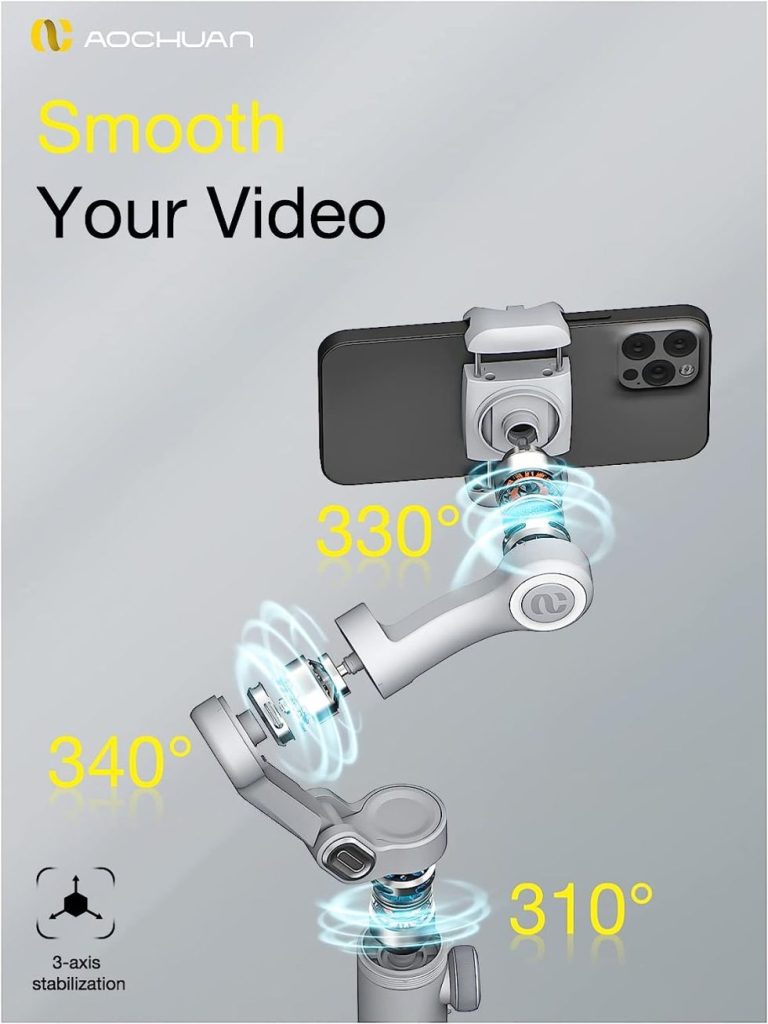Jeder Fotograf weiß, dass ein mobiler Stabilisator nur so gut ist wie die Fähigkeiten des Bedieners. Schnelle Schwenks erfordern ein tiefes Verständnis für die Möglichkeiten und Grenzen der Ausrüstung. Modern mobile Stabilisatoren sind mit fortschrittlichen Motoren ausgestattet, die schnelle Bewegungen ausführen können, aber der Schlüssel liegt darin, wie Sie diese Übergänge einleiten und ausführen. Analysieren Sie zunächst die Reaktionseinstellungen des Gimbals - die meisten Modelle bieten eine einstellbare Motorstärke, die bestimmt, wie stark sie Ihren Bewegungen entgegenwirken. Für schnelle Schwenks benötigen Sie in der Regel eine mittlere bis hohe Ansprechempfindlichkeit, um die Stabilität bei schnellen Richtungswechseln zu gewährleisten.
Perfekter Griff für perfekte Kontrolle des mobilen Stabilisators
Die Position Ihrer Hand kann die Leistung eines Gimbals bei schnellen Schwenks stark beeinflussen. Im Gegensatz zu langsamen, ruhigen Aufnahmen, die eine einfache Handhabung ermöglichen, erfordern dynamische Übergänge einen festeren Griff. Legen Sie Ihre dominante Hand auf den Griff, mit den Fingern fest, aber nicht zu fest - Sie brauchen Kontrolle, ohne nervöses Zittern zu verursachen. Die andere Hand sollte den Arm des Gimbals sanft führen und bei Richtungswechseln helfen. Viele Profis passen ihren Griff in der Mitte des Schwenks an und ändern die Position ihrer Hand, wenn der Gimbal seine Richtung ändert. Probieren Sie verschiedene Griffe aus und beobachten Sie, wie sie sich auf die Geschmeidigkeit des Schwenks auswirken. Denken Sie daran, dass Ihr Griff die natürlichen Gleichgewichtseigenschaften des Gimbals unterstützen und nicht gegen sie ankämpfen sollte. Ein idealer Griff minimiert die Körperschwingungen und ermöglicht gleichzeitig eine präzise Steuerung der Bewegungsgeschwindigkeit und -richtung.

Die Physik hinter glatten, schnellen Schwenks
Verstehen der Mechanik einer Kardanisch ermöglicht es Ihnen, schnelle Schwenks besser auszuführen. Wenn Sie einen schnellen Schwenk einleiten, wirken die Motoren des Gimbals Ihren beabsichtigten Bewegungen und ungewollten Verwacklungen entgegen. Auf diese Weise entsteht ein empfindliches Gleichgewicht zwischen Benutzereingabe und automatischer Korrektur. Die sanftesten schnellen Schwenks kombinieren eine allmähliche Beschleunigung und Verlangsamung - stellen Sie sich vor, Sie zeichnen mit Ihren Bewegungen eine sanfte S-Kurve, anstatt einer geraden Linie. Der Gimbal funktioniert am besten, wenn Sie ihm mit sicheren, zielgerichteten Bewegungen eine klare Richtung vorgeben. Üben Sie, die Geschwindigkeit Ihrer Schwenks zu ändern und beobachten Sie dabei die Reaktionen des Gimbals. Sie werden den idealen Punkt finden, an dem die Motoren perfekt mit Ihren Bewegungen zusammenarbeiten und selbst bei höheren Geschwindigkeiten sanfte Übergänge ermöglichen. Dieses physikalische Verständnis verwandelt raue, ruckartige Schwenks in Übergänge in Filmqualität.
Fortgeschrittene Footwork-Tipps für Gimbal Pans
Professionelle Videofilmer wissen, dass gute Gimbal-Arbeit am Anfang steht. Schnelle Schwenks erfordern eine koordinierte Fußarbeit, um die Stabilität während der gesamten Bewegung aufrechtzuerhalten. Beginnen Sie mit schulterbreit auseinander stehenden Füßen und leicht gebeugten Knien, um die Bewegung abzufangen. Wenn Sie mit dem Schwenken beginnen, drehen Sie sich eher aus der Hüfte als aus den Armen, damit sich Ihr gesamter Oberkörper gleichmäßig drehen kann. Für dramatischere Schwenks machen Sie kleine Schritte in die Richtung der Bewegung - so verteilt sich die Bewegung auf den ganzen Körper und konzentriert sich nicht auf die Arme. Wenn Sie einen mobilen Gimbal für Schwenks von 180 Grad oder mehr verwenden, üben Sie die "Rankenschritt"-Technik, bei der Sie einen Fuß hinter den anderen setzen, um Ihren Körper gleichmäßig zu drehen. Diese grundlegende Fußarbeit verhindert das "menschliche Stativwackeln", das schnelle Schwenks oft zunichte macht.

Schnelle Schwenks erreichen
Die meisten hochwertigen mobilen Kardanringe bieten anpassbare Einstellungen zur Optimierung der Leistung bei schnellen Schwenks. Probieren Sie zuerst die Einstellung des Motordrehmoments aus - schnelle Schwenks profitieren oft von einem etwas höheren Drehmoment, um die Stabilität bei schnellen Richtungswechseln zu erhalten. Achten Sie auf die Einstellung für den Verfolgungsmodus des Gimbals; einige Modelle bieten einen speziellen "Sport"-Modus, der speziell für dynamische Bewegungen entwickelt wurde. Wenn Ihr mobiler Gimbal über einstellbare Gegengewichte verfügt, sollten Sie versuchen, Ihre typische Kameraeinstellung leicht auszugleichen, um das Ansprechverhalten bei Schwenks zu verbessern. Viele Profis erstellen benutzerdefinierte Voreinstellungen für schnelle Schwenkszenen und speichern spezifische Motorstärken und Reaktionskurven für verschiedene Aufnahmesituationen. Denken Sie daran, diese Einstellungen unter realen Aufnahmebedingungen zu testen, da die idealen Einstellungen je nach Kameragewicht, Objektivauswahl und Ihrem persönlichen Bewegungsstil variieren.
Kreative Anwendungen für schnelle Schwenkübergänge
Schnelle Schwenks mit einem mobilen Stabilisator sind mehr als nur eine technische Übung - sie sind ein wirkungsvolles Mittel zur Erzählung von Geschichten. Verwenden Sie schnelle Schwenks, um Energie und Dringlichkeit in Actionsequenzen zu erzeugen oder um wichtige Elemente im Bild dramatisch in Szene zu setzen. Viele Kameraleute verwenden schnelle Schwenks als "unsichtbare Schnitte" zwischen Szenen, um die visuelle Kontinuität bei Zeit- oder Ortswechseln zu wahren. Bei der Aufnahme von Interviews oder Dokumentarfilmen kann ein gut ausgeführter schneller Kameraschwenk auf natürliche Weise den Fokus zwischen den Motiven verändern. Sobald Sie die technischen Aspekte beherrschen, eröffnet Ihnen ein mobiler Stabilisator diese kreativen Möglichkeiten. Versuchen Sie, schnelle Schwenks mit anderen Bewegungen zu kombinieren - bewegen Sie sich während eines horizontalen Schwenks nach vorne oder kippen Sie nach oben, wenn Sie eine Drehung ausführen.
Letztlich
Wenn Sie die Technik des schnellen Schwenks mit einem mobilen Stabilisator beherrschen, eröffnen sich neue kreative Möglichkeiten für Ihre Videografie. Richtig ausgeführt, verleihen diese dynamischen Übergänge Ihrem Material professionellen Schliff und erzählerische Kraft. Denken Sie daran, dass Sie Ihre Technik nur durch bewusstes Üben beherrschen - nehmen Sie sich die Zeit, Ihre Technik zu perfektionieren, ohne den Druck, tatsächlich zu filmen. Moderne mobile Stabilisatoren sind sehr leistungsfähige Werkzeuge, aber ihr wahres Potenzial entfaltet sich erst in Kombination mit

